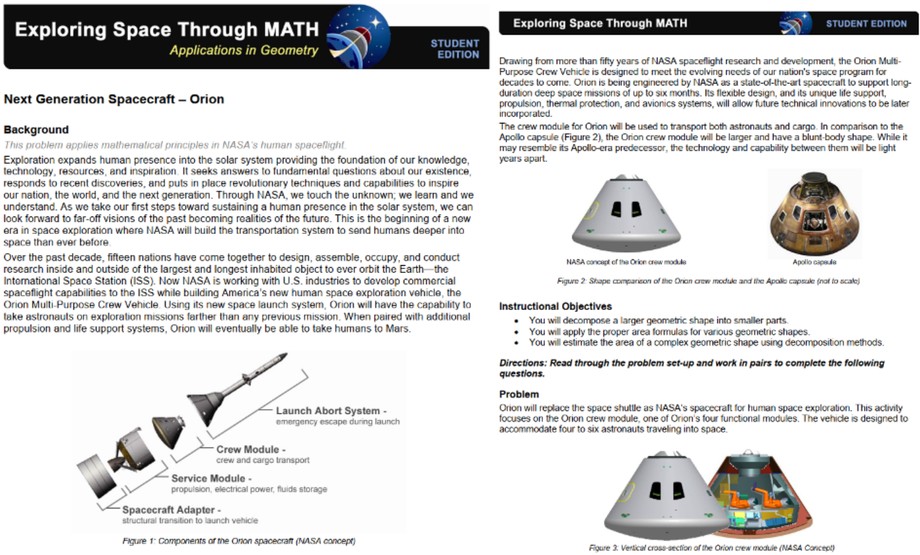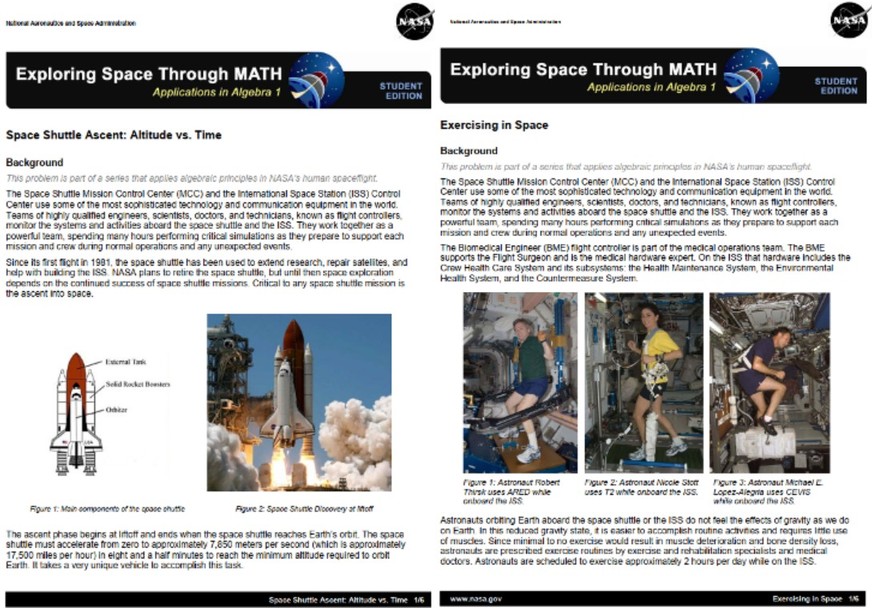6 Geometry STEM Lessons from NASA
Here are six Geometry STEM Lessons produced by NASA. These geometry lessons use the 5-E’s Instructional Model: “Engage, Explore, Explain, Extend, and Evaluate” to accomplish the lesson objectives. Geometry topics taught and covered include: the Pythagorean Theorem, volume of a cylinder, properties of circles, arc lengths, measurement of angles, volume of geometric solids, and estimating the area of a complex geometric shape. The Educator editions give the answers to all of the geometry problems. Some of these geometry lessons request students to be familiar with using a calculator, such as the Texas Instruments Nspire. Other geometry learning materials that you may want to check out are 15 Geometry Textbooks and 227 Geometry Videos by Khan Academy.
OH CHUTE!
Engineers at NASA’s Johnson Space Center have designed and tested the Capsule Parachute Assembly System (CPAS) for the new crew exploration vehicle. Since the actual piece of equipment is large, engineers use small 3D models to analyze size and performance. Students will create a table, using scale factor, showing the actual dimensions and the scale models dimensions of several structural pieces of the CPAS structure. Area and volume calculations will also be performed to ensure that the CPAS design meets necessary requirements.
Students will
- use scale factor to complete a table;
- use the Pythagorean Theorem;
- calculate the volume of a cylinder;
- calculate the area of a circle;
- investigate how changes in scale factor affect volume; and
- investigate how changes in scale factor affect area.
Lesson Files:
It All Comes Full Circle
When the space shuttle launches from Kennedy Space Center, it must launch within a certain time frame called a launch window in order to successfully dock with the International Space Station. When the space shuttle reaches orbit both vehicles are traveling in circular orbits around the Earth. Students will use circle properties to predict and monitor the vehicles positions.
Students will
- use geometric definitions to describe the properties of circles;
- find the circumference of circles;
- calculate arc lengths;
- find the measure of central angles; and
- use the properties of similarity, such as scale factor.
Lesson Files:
- It All Comes Full Circle Educator Edition
- It All Comes Full Circle Student Edition
- Video: Real World: Calculating Shuttle Launch Windows (6:48, mp4, 50 mb)
The NBL Pool
Astronauts train for spacewalks at one of the largest indoor pools in the world—NASA’s Neutral Buoyancy Laboratory (NBL), located at the Sonny Carter Training Facility in Houston, Texas. NASA uses the NBL pool not only for astronaut training and the refinement of spacewalk procedures, but also to develop flight procedures and verify hardware compatibility. Students will use geometry to compare and contrast the dimensions of the NBL pool, the International Space Station, and a football field.
Students will
- apply formulas for volume of geometric solids, using appropriate units of measure; and
- solve application problems involving geometric solids.
Lesson Files:
- The NBL Pool Educator Edition
- The NBL Pool Student Edition
- Video: Fluid Dynamics – What a Drag! (7:13 mins, mp4, 76 mb)
- The NBL Pool Educator Edition for Nspire calculator
- The NBL Pool Student Edition for Nspire calculator
- Note: The following files are software specific file for Texas Instrument Nspire calculators:
- The NBL Pool Document for Nspire calculator – The Pool (TNS)
- The NBL Pool Solution Document for Nspire calculator – The Pool (TNS)
Lunar Rover
Students will apply the distance formula and the Pythagorean Theorem to determine the minimal path and minimal time for the Lunar Rover to perform tasks on the surface of the Moon.
Students will
- create a scale drawing to model a real life problem;
- apply the Pythagorean Theorem and distance/rate formula (d = rt); and
- analyze data to find a solution.
Prerequisites: Prior to this activity, students should have experience applying formulas. Students should be familiar with using calculators and evaluating formulas, as well as have a basic knowledge of scale factor and application of the Pythagorean Theorem.
Lesson Files:
- Lunar Rover Educator Edition
- Lunar Student Edition
- Video: How Do Rovers Drive on Mars? (1:00, mp4, 14 mb)
- Video: Opportunity: Making Tracks on Mars (3:18, mp4, 40 mb)
An Astronaut In Motion
Maneuvering around or performing a task while in the microgravity environment of space can be a difficult feat. Doing these things while wearing a space suit may present additional challenges. Students will investigate how NASA researchers simulate an astronaut’s movement in a space suit by creating an avatar and applying transformation principles.
Students will
- apply translations in the coordinate plane; and
- apply reflections over the y-axis in the coordinate plane.
Prerequisites: Students should have prior knowledge of scatter plots, types of correlations, linear equations (slope and y-intercept) and linear graphs. Students should also have experience using a graphing calculator or spreadsheet application to create scatter plots and to find linear regression equations.
DOWNLOADS
- An Astronaut In Motion Educator Edition for Nspire calculator
- An Astronaut In Motion Student Edition for Nspire calculator
- Note: The following file is a software specific file for Texas Instrument Nspire calculators:
- An Astronaut In Motion Document for Nspire calculator (TNS)
- Video: Motion Capture and Motion Builder Demo (4.25, mp4, 17 mb)
Next Generation Spacecraft
Students will decompose the cross section of a Crew Module into smaller shapes to estimate its area.
Students will
- decompose a larger geometric shape into smaller parts;
- apply the proper area formulas for various geometric shapes; and
- estimate the area of a complex geometric shape using decomposition and graphical methods.
Prerequisites: Prior to this activity, students should have had experiences decomposing geometric figures (breaking figures into smaller shapes) and applying area formulas. Students should be familiar with using calculators in evaluating formulas.
Lesson Files:
- Next Generation Spacecraft Educator Edition
- Next Generation Spacecraft Student Edition
- Video: Orion MPCV: The Journey Begins (7:08, mp4 34 mb)
- Video: Orion: From Factory to Flight (7:42, mp4, 34 mb)
-love learning -your best ed lessons guide, Scott





1 Comment